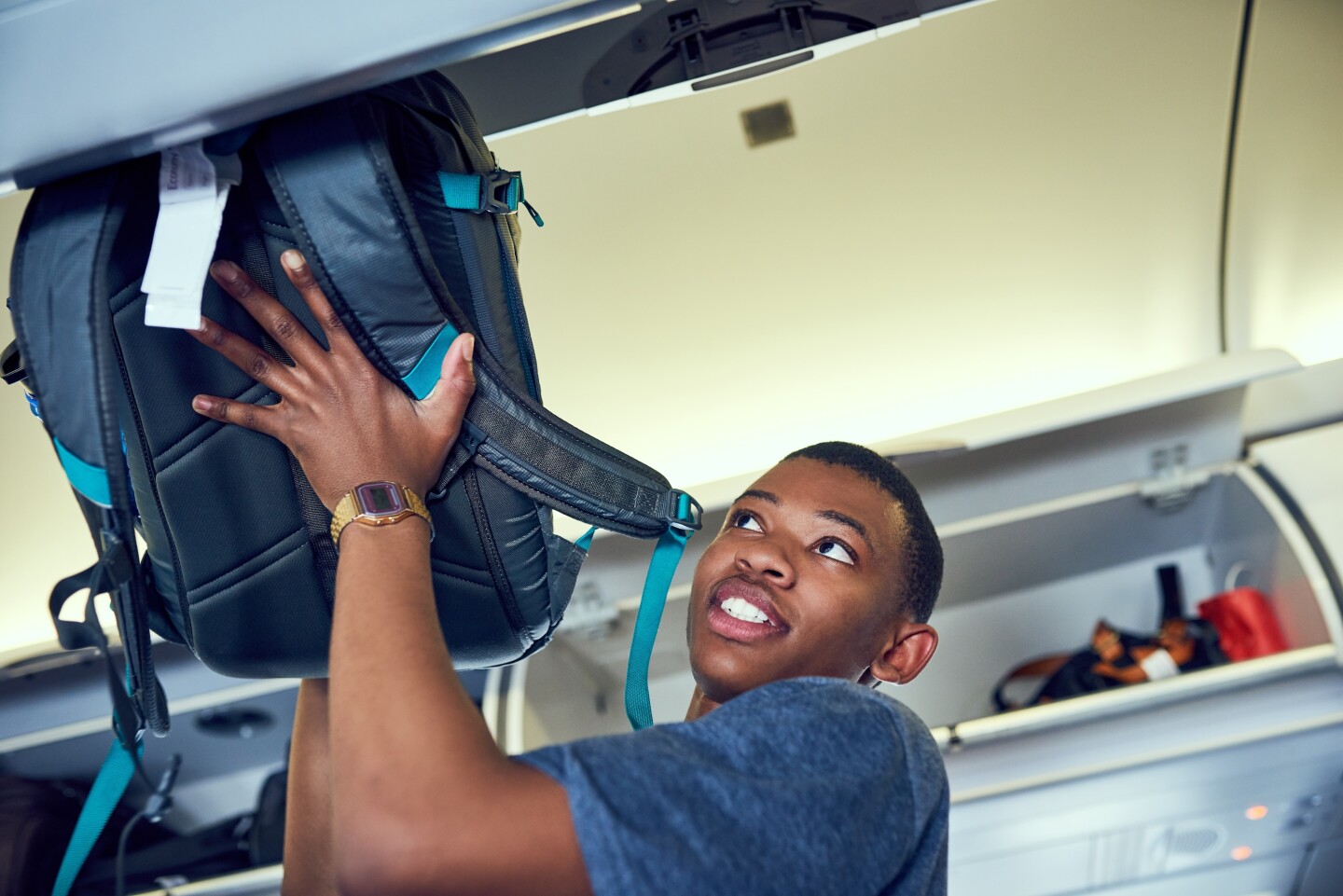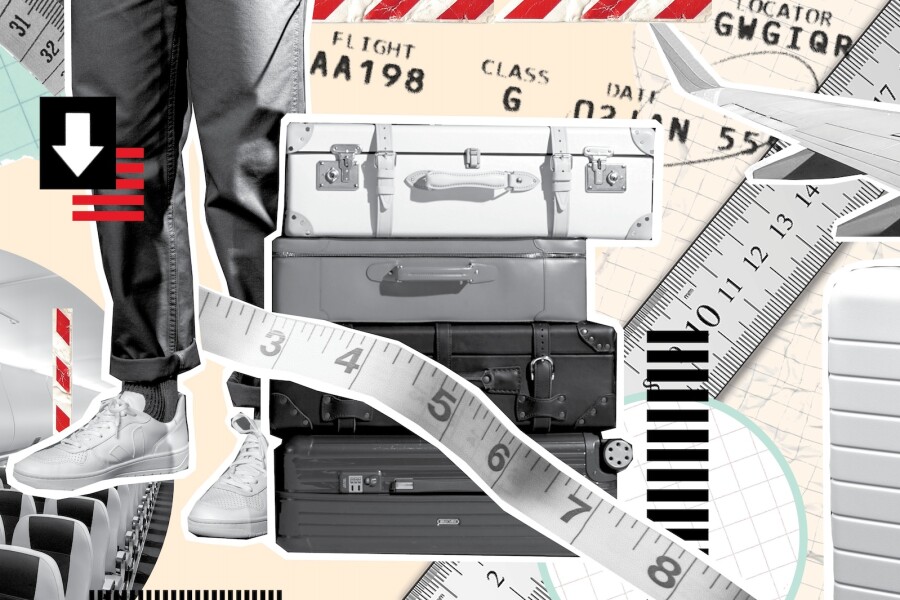Even if you now have your packing strategy down to a science, you’ve probably had at least one run-in with a carry-on bag that won’t fit into an unexpectedly small overhead bin as other passengers glare with disapproval. Even worse, maybe you’ve been forced to gate-check a bag when it didn’t fit in the dreaded measurement box snugly. Did the airline website understate how seriously gate agents would take size limits, or did you flat-out forget to check?
Restrictions for carry-on luggage vary by airline, type of aircraft, and even ticket class—meaning that suitcase you brought onboard for one flight might be gate-checked on another depending on the size or the carry-on weight limit. Before your next trip, use this guide to make sure your bag will fit in the overhead compartment.

Carry-on luggage requirements can vary from airline to airline, especially on low-cost carriers.
Courtesy of Omar Prestwich/Unsplash
What size should your carry-on luggage be?
On domestic flights within the United States, a carry-on bag that’s smaller than 22 x 14 x 9 inches (45 linear inches), including handles and wheels, will meet the size restrictions of all major airlines, such as United and Alaska. To calculate your suitcase’s size in linear inches, just add the length, height, and depth (or width) together. Although some airlines—notably Southwest and Spirit Airlines—will allow bags of up to 50 linear inches, it’s a good idea to look for a bag that’s around 45 linear inches or smaller if you’re shopping for a new carry-on.
The size limit varies more widely on non-U.S. airlines, especially low-cost carriers, but unless you’re flying on say, a small island-hopper in the Azores, 45 linear inches or smaller will allow you to meet the requirements of nearly all of them.
Related: How to Pack a Suitcase Like a Flight Attendant

A travel backpack is an ideal carry-on and is generally easier to put in the overhead bin than a rolling suitcase.
Photo by PeopleImages.com - Yuri A/Shutterstock
Weight limits for carry-on luggage
Aside from Frontier (35 pounds) and Hawaiian Airlines (25 pounds), most major U.S. airlines do not have a weight limit for carry-on bags. However, they generally require travelers to be able to lift their own bags into the overhead compartment since flight attendants have a few good reasons for not helping with that. The exception is for passengers with disabilities, per the Airline Passengers with Disabilities Bill of Rights, which states that airlines “must provide assistance, if requested, such as . . . stowing and retrieving carry-on items, including assistive devices.”
Outside the United States, however, most airlines have a weight limit for carry-on bags. They can range anywhere from 11 pounds (Air China) to 50 pounds (British Airways). Many budget airlines, both domestic and international, have strict guidelines and fees for the number and size of carry-on bags—and enforce them—so be sure to check your specific airlines’ requirements when traveling abroad.
Carry-on sizes for major domestic airlines (United States)
The carry-on sizes and weights listed in the following tables are generally for a standard, economy ticket (though some airlines, such as Spirit and EasyJet, charge for carry-on baggage beyond a personal item). Some airlines allow additional carry-ons, a larger bag, or a bag that weighs more than the standard economy weight if you have booked a premium economy, business-, or first-class ticket.
Carry-on sizes for international airlines
How many carry-ons can you bring?
Most major domestic and international airlines allow economy passengers one carry-on and one personal item. (Business-, first-, or premium-class passengers are usually allowed more.) Basic economy tickets typically allow one personal item but no use of the overhead bin compartments.
What is a personal item?
A personal item must fit under the seat in front of you and usually includes items like purses, small handbags and backpacks, briefcases, and laptop bags. Some airlines allow diaper bags, cameras, and duty-free merchandise in addition to a carry-on and personal item. Most airlines will also gate-check strollers.
Related: 9 of the Best Travel Backpacks for Your Next Trip

While carry-on luggage can go in overhead bins, personal items must be small enough to fit under the seat in front of you.
Illustration by Shutterstock
How to measure your carry-on luggage
To calculate the size of your carry-on bag, measure the length, height, and depth (or width) of your bag. Added together, you’ll get your total linear inches. For example, a bag with a length of 20 inches, width of 12 inches, and depth of 6 inches would be 20+12+6 = 38 linear inches.
If you don’t have a measuring tape handy, you can also find the dimensions of your bag on the seller’s product page under the product specifications. Many bags also list the dimensions on the hang tag, so instead of throwing that out after purchase, tuck it into one of the pockets so you’ll always have it to show any inquiring airline staff. Most airlines also have measurement boxes where you can size-up your carry-on before you check in to your flight. This way, you’ll know before you get to the gate whether or not it will fit in the overhead compartment.
What counts as a carry-on?
Generally, a small rolling suitcase, duffel bag, or larger backpack will count as a carry-on bag. Garment bags count as carry-ons, as long as they follow the dimensions specified by the airline. For instance, American Airlines allows passengers to carry on a soft-sided garment bag up to 51 inches in lieu of a standard piece of luggage.
By law, airlines are required to allow passengers to substitute a small musical instrument for a carry-on bag as long as it fits under the seat or in the overhead compartment. Travelers may want to choose a preboarding option to ensure there is space for the instrument, which is not guaranteed.
Travelers can purchase a seat for larger instruments (such as a cello), as long as the instrument adheres to the airline’s size and weight guidelines. Military bags and sports equipment are also allowed as carry-on luggage, although bigger equipment—such as longboards, tennis rackets, or snowboards—may be charged the standard checked baggage fee, depending on the airline’s carry-on rules.
What can you take in your carry-on and personal item?
Carry-on luggage must pass through airport security and, therefore, cannot include dangerous materials or excessive amounts of liquid. According to the TSA’s 3-1-1 liquids rule, these can be a maximum of 3.4 ounces (100 ml) per item and must fit into a quart-size plastic bag; each passenger is allowed one quart-size bag.
In general, food is allowed in your carry-on, although some items may be subject to the TSA’s liquids restrictions, such as peanut butter. After a great debate, it announced that since peanut butter has no definite shape and takes the shape of its container, it is, by their standards, a liquid. That’s only one of several surprising things the TSA won’t let you carry freely onboard.
Carry-on luggage cannot contain cutting instruments, explosives, or flammable materials, although some of these prohibited items are allowed in checked bags. If you have any doubt about a specific item, the TSA’s What Can I Bring? site is a helpful resource to consult.
To make sure all your stuff fits into the right size carry-on, consider packing cubes, which save space and help organize your belongings. And if you want to forgo the luggage struggle altogether, including checking in a bag, you can use a company to ship your luggage and breeze onto the plane with just a stylish fanny pack.
This article was originally published in 2019 and most recently updated on February 10, 2025, with current information. Jessie Beck contributed to the reporting of this story.








